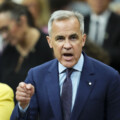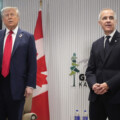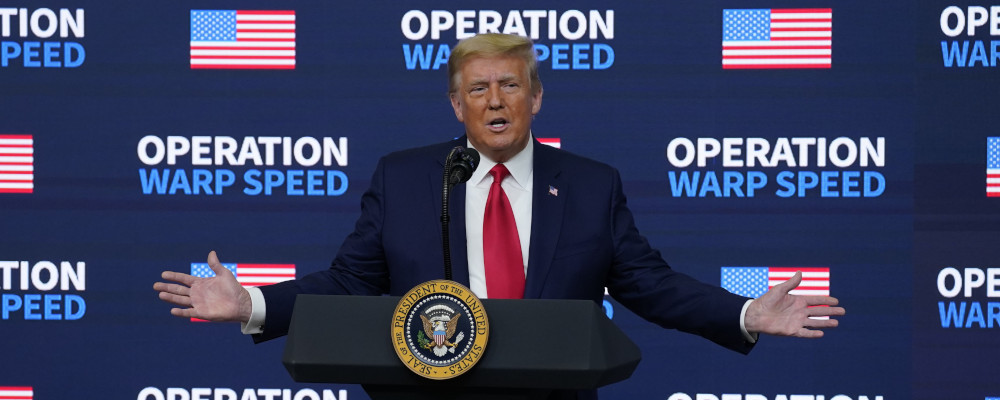A year ago we huddled indoors afraid for our future, traumatized by scenes of European and American hospitals overrun with critically ill patients. We prayed that vaccine development could somehow be compressed from a five-year development timeline to be ready much earlier to protect us from overwhelming waves of infection.
It was our best hope.
The carnage of the 1918-19 Spanish Flu was what we might be facing if vaccines couldn’t be developed in a timely fashion. They were likely going to save millions of lives and save our economy.
I dislike most things about Donald Trump and welcome the stability that his successor has brought, even if I don’t agree with his every policy, but Trump does deserve credit for Operation Warp Speed.
The program was officially announced one year ago on May 15, 2020 as a partnership between the U.S. government and private industry to rapidly accelerate development and roll out of vaccines, diagnostics and therapeutics. Moncef Slaoui, the former head of vaccine development at GlaxoSmithKline (GSK), was recruited to lead the effort.
The goal was to promote many different vaccine technologies simultaneously with aggressive funding and rapid but safe approval. The hope was that this would compress timelines and produce at least one if not multiple safe and effective vaccines. The funding of multiple options would be more costly but ideally lead to much earlier success. Canada had no such plan nor the facilities needed for vaccine production.
A number of pharma companies were beneficiaries, each with plans to produce vaccines using different technologies, some adapted from previous successful vaccines and others more novel. A total of $18 billion was awarded for early clinical vaccine trials and accelerated manufacturing.
When the power of vaccination is so obvious, why do so many people have warped thinking about its benefits?
Moderna received an additional $1.53 billion to bring total investment to $2.48 billion. Johnson & Johnson in collaboration with Janssen Pharmaceutical similarly received a total of $1.456 billion. As well Novavax received $1.6 billion, Sanofi with SKF $2.1 billion. Oxford University developed a viral vector vaccine with the support of research foundations and government grants and then partnered with AstraZeneca who received $1.2 billion in Warp Speed funding.
Pfizer elected not to accept government funds for research and development, so as not to be constrained by bureaucracy and reporting requirements. They did receive $2 billion to secure 100 million doses for the U.S. if the vaccine was effective. Their partner BioNTech received $445 million from the German government.
The miraculous result of this partnership is that five highly effective vaccines rolled out in less than a year.
While the primary intent was vaccine nationalism and guaranteed early U.S. access, the vaccine development and licensed production facilitated by Operation Warp Speed has already saved millions of lives worldwide. However that is not yet nearly enough.
The Trump administration failed to work collaboratively with state and federal governments to organize, supply and fund the infrastructure desperately needed to get shots in arms quickly and efficiently. Prime Minister Justin Trudeau will somehow likely overcome even worse failures.
Countries that had early vaccine procurement such as Israel, the U.K. and the U.S. are seeing dramatic reduction in new cases and deaths. Brazil, other Latin American countries and India continue to show the tragedy of the combination of poverty, ineffective leadership and limited vaccine access.
When the power of vaccination is so obvious and crucial to saving lives, why do so many people have warped thinking about its benefits? Vaccine hesitancy is being fuelled by a vocal minority willing to distort the truth with outright lies and misrepresentation of facts.
All therapies have some risk. The true risks of vaccination are very small, but when a death occurs in a healthy person due to a fatal blood clot it is both tragic and frightening. It is real but fortunately relatively rare. Anxiety can be greatly reduced by a simple blood test showing that your blood platelet count is normal and not low due to their consumption by a rare allergic type reaction to the vaccine. While this test is simple and readily available it has not been universally recommended perhaps for fear of swamping health care. This may need to change as vaccine hesitancy for viral vector vaccines increases because of both the small risk and poor messaging. We need to clarify the true risk and use readily available ways of making an early diagnosis to prevent serious harm.
There has been concern raised about associating with vaccinated people because the vaccine could shed spike protein antigen to a nearby unvaccinated person. Of course this is impossible. One school in Florida has informed its teachers that those vaccinated will not be allowed to teach, since vaccinated teachers could cause stillborn children in unvaccinated mothers who may be nearby. Lies that are repeated often enough and shared on social media are often believed by skeptics of vaccination.
Anti-vaxxers also argue that there is no need for vaccines if only simple, highly effective and available medicines were routinely used. The use of ivermectin and hydroxychloroquine is being touted as a suppressed life-saving treatment better than vaccines despite their lack of proven benefit in properly conducted trials. The argument is that these drugs if used more frequently would make these dangerous experimental vaccinations unnecessary. Randomized trials have shown at best mild benefit early in disease or to those mildly affected. They clearly are not an alternative to vaccination.
As a result of the extreme anti-vaccine sentiment held by anti-vaxxers and politicized Republicans, Canada may end up eventually vaccinating a higher percentage of our population than the U.S. and ultimately reaching a higher level of herd immunity.
Fans of Star Trek remember Captain Kirk telling Mr. Sulu to engage warp drive to travel faster than the speed of light and escape threats to their vessel. This speed would be achieved with the incredible power created by the collision of matter and antimatter. While Einstein’s theory of relativity indicates that the speed of light can not be exceeded, scientists now believe it may be possible to achieve warp speed by compressing space in the direction of travel while still travelling at the speed of light.
While achieving warp speed may yet not be possible it seems harder to convince people with warped thinking to see the light at any speed.
Recommended for You

Kirk LaPointe: B.C.’s ferry fiasco is a perfectly Canadian controversy

‘I want to make Canada a freer country’: Conservative MP Andrew Lawton talks being a newbie in Parliament, patriotism, and Pierre Poilievre’s strategy

The Notebook by Theo Argitis: Trump halts trade talks, Carney’s trade-offs and John McCallum’s legacy

The Weekly Wrap: The Liberals must abandon their internet regulation agenda



